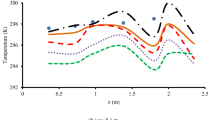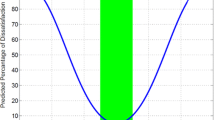Abstract
This work seeks to analyze the thermal comfort of the occupants in a large building of Commerce and Services, integrating measures of assessment and energy efficiency promotion. The building is still in the construction phase and at its conclusion, will correspond to a supermarket located in the Central region of Portugal. For the evaluation of thermal comfort, Fanger’s methodology was used, where the Predicted Mean Vote (PMV) and Predicted Percentage of Dissatisfied (PPD) were calculated based on a detailed analysis of the environmental variables. These are essential to obtain, namely, mean air velocity, mean radiant temperature, mean air temperature and relative humidity. The other crucial variables are the metabolic rate and the thermal clothing resistance. The simulations necessary for the thermal comfort assessment were performed in ANSYS Fluent, in order to minimize the energy consumption in the cold thermal zone of the building, the sales area with frozen and chilled food, by means of reducing the inflow of air, without compromising thermal Comfort. The final results showed that the reduction of the amount of air to be inflated did not compromise the thermal comfort of the occupants. The Computational Fluid Dynamics (CFD) methodology allowed the creation of comfort maps, albeit for a single zone due to computational limitations. According to the results, the most comfortable zone was located right below the air insufflation with the summer being a more comfortable season. In winter, the main problem detected was the cold located near the floor.
Access this chapter
Tax calculation will be finalised at checkout
Purchases are for personal use only
Similar content being viewed by others
References
Official Journal of the European Union A UE e a união de energia e a ação climática. Bruxelas, p 4 (2017)
Comini, R., Clement, F., Beirão, D., et al.: Eficiência Energética Nos Edifícios Residenciais Manual do Consumidor. Lisboa, Portugal (2017)
Höppe, P., Martinac, I.: Indoor climate and air quality. Review of current and future topics in the field of ISB study group 10. Int. J. Biometeorol. 42, 1–7 (1998)
Parsons, K.C.: Human Thermal Environments: The Effects of Hot, Moderate, and Cold Environments on Human Health, Comfort, and Performance, 3rd edn. Taylor & Francis, London (2014)
Lindberg, U., Fahlén, P., Axell, M., Fransson, N.: Thermal comfort in the supermarket environment – multiple enquiry methods and simultaneous measurements of the thermal environment. Int. J. Refrig. 82, 426–435 (2017). https://doi.org/10.1016/J.IJREFRIG.2017.06.020
Gowreesunker, B.L., Tassou, S.A.: Approaches for modelling the energy flow in food chains. Energy Sustain. Soc. 5(1), 1–18 (2015). https://doi.org/10.1186/s13705-015-0035-y
ASHRAE ASHRAE Handbook - HVAC Applications (2011)
ISO 7730 Ergonomics of the thermal environment – Analytical determination and interpretation of thermal comfort using calculation of the PMV and PPD indices and local thermal comfort criteria (2005)
Dias AAC Avaliação da perceção da influência do conforto térmico na produtividade. Universidade do Minho (2013)
Miguel, A.S.: Manual de Higiene e Segurança do Trabalho, 13th edn. Porto Editora, Portugal (2014)
ASHRAE Standard 55P Thermal Environmental Conditions for Human Occupancy. ASHRAE Stand (2003)
Lindberg, U., Fahlén, P., Axell, M., Fransson, N.: Thermal comfort in the supermarket environment – multiple enquiry methods and simultaneous measurements of the thermal environment. Int. J. Refrig 82, 426–435 (2017). https://doi.org/10.1016/j.ijrefrig.2017.06.020
d’Ambrosio Alfano, F.R., Dell’Isola, M., Ficco, G., et al.: Thermal comfort in supermarket’s refrigerated areas: an integrated survey in central Italy. Build. Environ. 166, 106410 (2019). https://doi.org/10.1016/j.buildenv.2019.106410
Mukhopadhyay, J., Haberl, J.: Reducing energy consumption in grocery stores: evaluation of energy efficiency measures. ASHRAE Trans. 120, 416 (2014)
Lindberg, U.: Research for the retail grocery context: a systematic review on display cabinets. Trends Food Sci. Technol. 100, 19–34 (2020). https://doi.org/10.1016/j.tifs.2020.03.027
Buratti, C., Palladino, D., Moretti, E.: Prediction of indoor conditions and thermal comfort using CFD simulations: a case study based on experimental data. Energy Procedia 126, 115–122 (2017). https://doi.org/10.1016/j.egypro.2017.08.130
Rodrigues, N.J.O., Oliveira, R.F., Teixeira, S.F.C.F., et al.: Thermal comfort assessment of a surgical room through computational fluid dynamics using local PMV index. Work 51(3), 445–456 (2015). https://doi.org/10.3233/WOR-141882
Nielsen, P.V.: Fifty years of CFD for room air distribution. Build. Environ. 91, 78–90 (2015). https://doi.org/10.1016/j.buildenv.2015.02.035
Daniela, R., Anna, B., Paolo, C.S., Alena, T.: Energy consumption and thermal comfort assessment in retail stores: monitoring and dynamic simulation applied to a case study in Turin. Energy Procedia 78, 1015–1020 (2015). https://doi.org/10.1016/j.egypro.2015.11.049
Parpas, D., Amaris, C., Sun, J., et al.: Numerical study of air temperature distribution and refrigeration systems coupling for chilled food processing facilities. Energy Procedia 123, 156–163 (2017). https://doi.org/10.1016/j.egypro.2017.07.247
Parpas, D., Amaris, C., Tassou, S.A.: Experimental investigation and modelling of thermal environment control of air distribution systems for chilled food manufacturing facilities. Appl. Therm. Eng. 127, 1326–1339 (2017). https://doi.org/10.1016/j.applthermaleng.2017.08.134
Al-Saadi, SNJ., Zhai, Z.: Impact of air distribution systems on thermal performance of supermarket. In: International Conference on Urban and Rural Energy and Environment. Jilin, China (2018)
Acknowledgements
The authors would like to express their gratitude for the support given by FCT within the R&D Units Project Scope UIDB/00319/2020 (ALGORITMI) and R&D Units Project Scope UIDP/04077/2020 (MEtRICs).
Author information
Authors and Affiliations
Corresponding author
Editor information
Editors and Affiliations
Rights and permissions
Copyright information
© 2020 Springer Nature Switzerland AG
About this paper
Cite this paper
Noversa, R., Silva, J., Rodrigues, N., Martins, L., Teixeira, J., Teixeira, S. (2020). Thermal Simulation of a Supermarket Cold Zone with Integrated Assessment of Human Thermal Comfort. In: Gervasi, O., et al. Computational Science and Its Applications – ICCSA 2020. ICCSA 2020. Lecture Notes in Computer Science(), vol 12254. Springer, Cham. https://doi.org/10.1007/978-3-030-58817-5_17
Download citation
DOI: https://doi.org/10.1007/978-3-030-58817-5_17
Published:
Publisher Name: Springer, Cham
Print ISBN: 978-3-030-58816-8
Online ISBN: 978-3-030-58817-5
eBook Packages: Computer ScienceComputer Science (R0)




